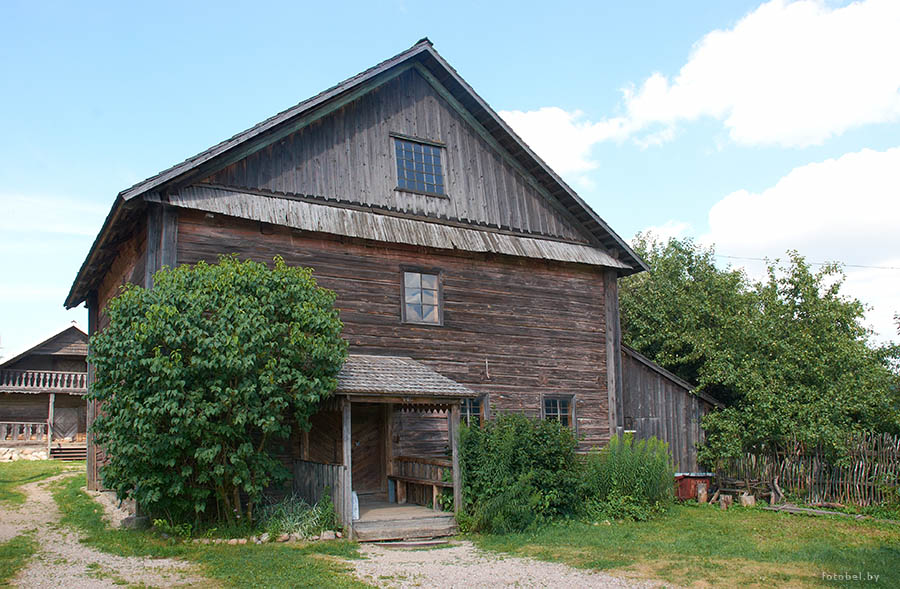Throughout its history, there have been various types of mills in Zaslavl: water, wind, steam. Only the steam engine, built in 1910 at the expense of a wealthy local resident Mekhedko-Savitsky, has survived to this day.
The mill is a log building in which the milling mechanisms are distributed over three floors. The heart of the mill (millstone supply) is located on the second floor. There is also a krupoderka-a machine for the production of cereals and cleaning grains from bran.
At first, the mill's mechanisms were powered by a steam engine, the so-called locomobile, whose boiler was heated with firewood. In the 30s of the twentieth century, the locomobile was replaced by a more efficient single-piston oil engine produced in 1928 at the Perkun plant in Warsaw, and in the late 1940s it was replaced by an electric motor.
Until 1989, the mill was used for grinding, but the building required repair. After restoration and museumification in 1990, the old building became the central object of the ethnographic complex "Mill" of the historical and cultural museum-reserve "Zaslavl", which includes the house of the suppliers, sviran and the forge.
The steam mill in Zaslavl is a monument of the industrial heritage of the early twentieth century. with an authentic building, mechanisms and production process.
House of the suppliers
At the beginning of the twentieth century, a house was built next to the mill, a kind of hotel for imported peasants waiting in line for grinding. In addition to the delivery workers, everyone who visited Zaslavl for various reasons could stay there.
The house was built on a stone foundation, covered with shingles. It consisted of an entrance hall and a clean (light) half. Unfortunately, the original building of the suppliers house has not been preserved. In 1992, the hotel was reconstructed by the Zaslavl Museum-Reserve in its original form. In the entrance hall of the suppliers house there is a small stove-stove, a corner cabinet( kutnik), shelves with ceramic, copper and brass dishes, a table with a samovar, a hanging washbasin. On the walls hang burnos (winter clothing made of felted cloth), as well as items of horse harness. In the second half of the house, the floor is made of boards, the walls are plastered and whitewashed. Important elements of the interior are a tiled stove, a floor with haylofts, a sofa and a German pendulum clock. Diagonally from the stove-an icon hangs in the red corner. The interior harmoniously combines the features of urban and rural life, which was typical for small-town houses of the early twentieth century.
Now the house of the suppliers hosts excursions, theatrical excursions, museum and pedagogical classes.
The barn
Sviran is a traditional building for the Belarusian economy of the second half of the XIX-early XX century, which was used for storing food, partially clothing and household items. This name was typical for the west of Belarus. In the east, the name “crate" has taken root.
A wooden sviran near the Zaslavskaya mill stands on a stone foundation. Its main facade is a gallery with a balcony, richly decorated with carvings. Inside, along the walls, there are grain storage bins. In the center there are shiyans woven from vines and straw, kublas of different sizes, and a harp on the side.
Sviran was built in 1890 in the village of Mikhnichi, Postavsky district, Vitebsk region. In the early 1990s, the historical and cultural museum-reserve was moved to Zaslavl, and in December 1997, a museum exposition was opened there.
The forge
The museum-workshop of blacksmithing production was opened in 1994. None of the numerous Zaslav forges has been preserved, so the existing one, typical for the Central region, was moved here from the village of Kamen in the Volozhinsky district of the Minsk region. The equipment and tools were mostly transported along with the building.
The forge is a convenient building measuring 4×4 meters. Inside, the working environment of the beginning of the XX century has been restored with all the necessary blacksmithing equipment. It consists of a forge, bellows, a deck with a one-horned anvil, manual grinding and drilling machines, numerous tools: hammers, pliers, cutters and punchers.
A shed is attached to the right wall of the forge to preserve firewood and coal. A special machine for shoeing horses is installed nearby, and a millstone – shaped stone-gbala lies on the ground here. It was used for stuffing iron rims on wooden cart wheels.
